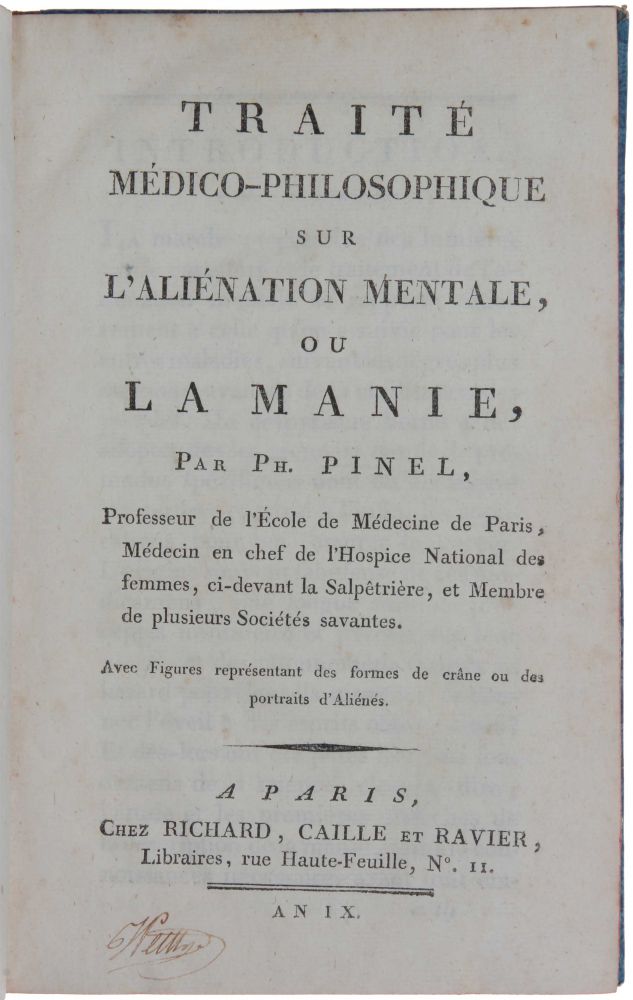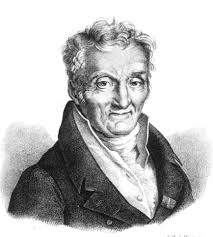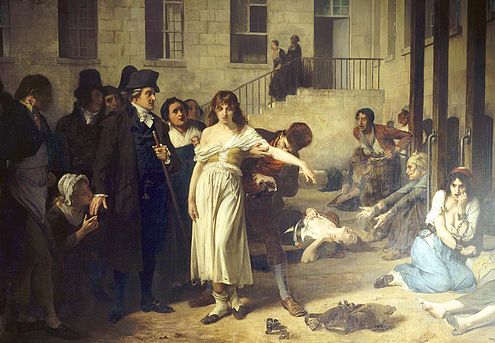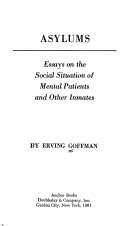Translators’ Preface

The impetus to this book came in the first instance from Dee Mangin, an academic primary care physician in Christchurch New Zealand, who drew the attention of one of us to a famous quote from Pinel: “It is an art of no little importance to administer medicines properly: but it is an art of much greater and more difficult acquisition to know when to suspend or altogether to omit them”[1].
Chasing the context of this quote further made it clear that this came from Pinel’s 1800 Treatise on Mental Alienation, and that his 1809 Treatise, his definitive work, had never been translated into English. Not only that but the translation of the 1800 Treatise was likely the worst translation of all time of any major work.[2]
The 1809 Treatise is a landmark work in the study of the mind. In these pages Pinel can be seen grappling with the enduring issues of insanity and their intersection with his time. He had to accommodate on the one hand contributions on the issue of insanity stretching back to the Greeks, while at the same time disengaging from the claims of other authorities such as the Church when it came for instance to dealing with pathological piety or religious delusions, and he had to negotiate these issues at a time of unparalleled social upheaval.
The tensions come through dramatically at points where he outlines clinical interventions to destroy religious materials he suspects have aggravated the condition of his patient, and where he blames misguided spiritual advice for leading to relapses. They also come through at points where he insists that remarkably different mental abilities may be differentially affected by illness; the reader may wonder why Pinel insists on what is for us so unremarkable but in fact these observations that seem so mundane posed a profound threat to the doctrine of the unity of the soul.
This was a point in history where longstanding domains of influence were being reconfigured[3]. Where once authorities such as the Church and traditions that stemmed from the ancients were unchallengeable, Pinel’s generation hoped that the science of ideas (as we have translated ideologie) might triumph and lead to progress of the kind produced within the physical and biological sciences[4]. As a prerequisite of such a science, it was necessary to cast aside tradition and observe patients.
The emerging asylums gave him an opportunity to chart the course of his patients’ disorders, and he described their situations and their problems with a vividness not seen since Hippocrates, and charted the course of their disorders in a way that had never been done before. He was the first to introduce the dimension of time into the consideration of mental illness, most evidently in his new notion of folie périodique, which helped lay the basis for the clinical approach to mental illness that flowered with Kahlbaum and Kraepelin, giving rise to our concepts of dementia praecox and manic-depressive illness.
Pinel hung his argument on these clinical descriptions, in a manner that is truly modern. While his classification of disorders may take some getting used to for modern readers, he outlines a range of clinical phenomena that readers will readily recognise – such as the role of expressed emotion in aggravating conditions, the concepts of relapse and relapse prevention, notions of an iatrogenic overlay on a primary condition, and problems that stem from polypharmacy – actually employing the term polypharmacie (para 279).

For those interested in historical antecedents to modern notions, this is the text to cite not only for the origins of these psychiatric notions, but also the first text to advocate clinical trials, as well as a recourse to probabilities and statistics to assess the efficacy of a treatment, and the first to call for an evidence based medicine.
When one gets used to the words being used, the classification Pinel suggests is in fact less alien than many might suspect, in that he distinguishes between shifting or multipolar states and conditions which show invariance or unipolarity in a manner that anticipates later 20th century thinking on unipolar and bipolar dichotomies[5]. In outlining these ideas he gives new meanings to the terms mania (“manie”) and melancholia (“mélancolie”) that had previously referred essentially to overactive and underactive insanity.
Of all the terms in the book we have struggled with none more than with manie. Mania was the equivalent English term of the time, but mania then and mania now are two completely different things. Over half of the patients admitted to a facility for the mentally ill from Pinel’s day through to 1900 had mania. Patients, who would now be diagnosed as having schizophrenia or agitated depression, were diagnosed as having manie. Emil Kraepelin’s creation of dementia praecox and manic-depressive in 1896 led to the demise of this form of mania, and the diagnosis shrank rapidly in frequency thereafter[6].
Manic-depressive illness remained a rare disorder for a century but in recent years we have succumbed to a “mania” for bipolar disorder that is leading all sorts of patients to be diagnosed as having manic episodes who until 10 years ago would never have been diagnosed in this way, including overactive infants. A mania diagnosis now leads on to treatment with mood-stabilizing drugs. Even the briefest reading of Pinel’s Treatise will make it clear he would never have condoned this.
There is in brief almost no commonality of meaning between Pinel’s manie and this 21st century mania and so we have struggled to find the right term for manie. Initially we translated it as insanity. There was one big disadvantage to this approach which is that it conceals Pinel’s realisation that ‘manie’ was one of the species of madness rather than the primary genus of mental alienation. This realization led him to a change in title between the first edition of the Treatise entitled, “Traité médico-philosophique sur l’aliénation mentale ou la manie,“ and the second edition entitled “Traité médico-philosophique sur l’aliénation mentale’.
Following input from Dora Weiner, Professor of Medical Humanities and History at UCLA, we finally settled on maniacal insanity, having rejected manic insanity en route as manic is too closely linked to the modern usage of mania. Maniacal in contrast paints a picture of overactivity, disorganisation and agitation that appeared to fit the bill quite well.
This brought us to mélancolie. Pinel’s new definition of melancholia focussed attention on the single delusional system that these patients typically had. This brought his melancholia quite close to the form of disorder that attracted this diagnosis for the greater part of the 20th century. On this basis we opted to hold on to melancholia.
One of the problems both Pinel had as a clinician, and we as translators have had, is that term delusion was not available to him. Mad patients with what would now be called delusions were then termed delirious (délirants). This led him to coin terms like exclusive or selective delirium (‘délire exclusif’). In translating the text we have grappled with issues like this and used delusion rather than delirium where indicated. The problem is that the French word “délire” does not clearly distinguish between the states referred to by the English terms “delusion” and “delirium”.[7]
Combining these difficulties, Pinel also famously introduced the concept of ‘manie sans délire’ to designate ‘moral’, ‘emotional’ or affective insanity, a notion easily confused with, and invariably mistakenly associated with psychopathy.[8] Reading the treatise however makes it clear that Pinel was distinguishing these states from ‘cognitive’ insanity characterised by delusions and that he had in mind a range of conditions without frank delusions or confusion that would for the most part today be categorised as mood disorders, or obsessive compulsive or other disorders. We have opted to translate this as insanity without delusions.
He illustrated the new disorder in a number of vivid vignettes, none better than his description of what happened when the Bicêtre was stormed by revolutionaries expecting to find and hoping to liberate many who had been inappropriately incarcerated (para 161). Thinking they had found one such individual, on the basis that he did not appear to have frank delusional ideas, they swept him off triumphantly, only to return him a short while later conceding that he was indeed mad. In the case of this and other concepts such as ‘folie raisonnante’, the quintessential French antecedent of the modern delusional disorder, we have translated the concept but retained the original French term also.
Pinel also uses dementia and idiocy as classificatory terms but many readers will suspect from the descriptions he gives that included among the dementias, and even among those with acquired idiocy, are some patients with dementia praecox.
We have also had to grapple with words like ‘chagrin’. Key to Pinel’s thinking was the possibility that the passions, of which chagrin is the most commonly mentioned, might give rise to insanity. This word was also common in English in 1809 and referred to a powerful affective state. But the word is rarely used in Britain now, while in America it is commonly used but refers to an inconvenient embarrassment rather than the kind of re-sentiment that might lead to madness. We have opted to translate it for the most part as chagrin, and sometimes as deep sorrow. The use of lost concepts like chagrin and misanthropy which once featured prominently in our efforts to understand ourselves, might hopefully act as a reminder that there have been other ways to see some of the issues at stake. Looking back can sometimes make visible the way forward – reculer pour mieux sauter.
While advocating an awareness of the passions as triggers to insanity, Pinel holds in conjunction all possible triggers to the conditions his patients evince, noting the physical changes in bodily functioning which he argues may lead on to secondary mental changes, and then outlining case histories in which events and circumstances that lead to powerful passions such as chagrin or anger trigger identical mental disorders to those that seem to have physical antecedents. This is an aetiological account that to this day still elicits support from all sides of psychiatry’s divides.
But he pierces to the heart of psychiatry’s divides in the treatment domain. First and famously he advocates moral treatment. As translators we have had to struggle with this term[9]. While it is often translated as psychological treatment, and the word psychology had been in existence from 1682, the idea of a psychotherapy did not come into existence before Freud and Janet almost a century later, and using a term like psychological treatment risks importing ideas into the mix that were just not available to Pinel. The term behaviour therapy maps well onto what he actually did, and behaviour therapists now cite him as the originator of their discipline[10], but equally this is a 20th century term that risks misleading. There are also ethical senses of the term moral that need to be carefully noted and held at arms’ length.[11]

We have opted in most instances for mental treatment as a way forward. This is a concept that can accommodate psychodynamic, behavioural and other possibilities. It opens a space for clinical wisdom of the type Pinel approves when he refers to Galen’s diagnosis and treatment of a women in love – outlined in footnote 3 in his introduction. There are at least three versions of this story in ancient medicine, of which the best known may be the Stratonica story. In this version, Seleucus, the King of Syria, then in his sixties is given the young Stratonica in marriage. His son Antiochus falls in love with her and wastes away, until the King’s physician makes the diagnosis on the basis of changes in the youths pulse whenever she is near[12]. Pinel makes clear his approval of clinical skill of this kind and his book is an attempt to build on this approach.
Finally he also advocates the use of a new institution purpose built to treat the mentally ill – one that he refers to as a hospice, which his pupil Esquirol later called an asylum. This would differ from the facilities in which the mad were previously confined in that patients would be separated according to the state of their disorder, would have their treatment plans tailored to their state, and where they might not only have their wits restored but where they might have had the opportunity to consolidate their recovery.
At a time when the height of fashion is to advocate treatment at home and to avoid admission to any kind of facility, Pinel offers a persuasive case against home treatment (See para 229 – 231, 275 – 276, 309, 352, 364, 395). He is confident in the capacities of an enlightened institution, with responsible people at its head, to improve the lot of the afflicted. He contrasts such an institution with the kinds of facilities previously available, such as the Hotel Dieu, where patients were likely to be brutalised by unsupervised care staff and debilitated by the treatment and procedures advocated by medical staff.

Pinel’s hospice is a far cry from the total institutions that Erving Goffman in his book Asylums, 150 years later, claimed created the clinical pictures that mental health staff categorised as illnesses[13]. It was a facility where recoveries were consolidated through work, and this example led on to the tradition of asylum farms and sewing rooms. Today we are apparently rediscovering the values of rebranded ecotherapy and ergotherapy, but it seems following Goffman’s total stigmatization of the Asylum recovering the notion of an asylum is just not possible.
In part, we have stuck with Pinel’s designation of the mental health facility within the Salpêtrière as a hospice as the word asylum was not available to him. But in part we have also opted for hospice rather than asylum, as the latter has been so stigmatised in our day that another word is needed to convey the benefits that enlightened institutional care might offer. To deny any possible benefits is fashionable but in a wider frame of reference risks looking more like a romantic denial of illness itself.
This book can be read on many different levels. On one level there are a series of human dramas Pinel so deftly sketches. He is first and foremost a clinician – one of the first modern clinicians, as Dora Weiner brings out in her preface to this volume and in her biography of Pinel[14]. On another level there is his articulation of the merits of the public domain, and its institutions, guided by the latest science. This is not just a matter of public versus private monies but rather as he makes clear a matter of the progress that can be expected when competing interests are brought to the light of day – a public morality that will be built on the progress of science.
In our own day confidence in public science is low. There is it seems a greater confidence in business and market solutions. But on this point Pinel throws down a challenge to the marketplace. Physical and mental treatments can all be marketed, as can a humane and decent delivery of these treatments, but the market cannot readily handle ‘No’. The market comes with a bias toward action and doing, ever giving another treatment if the first fails, or combining treatments in ever more elaborate cocktails. But there is here a fundamental retreat from wisdom, as the 1800 quote cited above illustrates. This quote is not repeated verbatim in the 1809 Treatise, but its thrust comes through repeatedly in the text. While Pinel advocates evaluating treatment, his treatment approach is ultimately underpinned by wisdom, a wisdom that may sometimes simply mean interfering as little as possible with the healing powers of nature – a central premise of his ‘médicine expectante’ (para 157). This was a wisdom that seemed to him more secure in the public domain.
David Healy, Louis C Charland, Gordon Hickish

The full translation of Pinel’s Treatise on Mental Alienation is available for free here or directly from Wiley’s online Library.
Acknowledgements: We have worked from the recent French reissue of the 1809 Traité:
Pinel P. Traité médico-philosophique sur l’aliénation mentale. Paris Seuil, 2005.
We gratefully acknowledge a huge input with key French words and passages from Dora Weiner, who co-edited the recent edition of the 1809 Traité with Jean Garrabé.
We had further input on concepts and practices from Monique Debauche, and Philippe Pignarre, the publisher of the 2005 edition. Marilyn Gower helped us to translate sentences from Latin.
[1] Mangin D, Sweeney K, Heath I. Preventive health care in elderly people needs rethinking. BMJ 2007, 335, 285-287.
[2] Weiner Dora B (2000). Betrayal! The 1806 Translation of Pinel’s Traité médico-philosophique sur l’aliénation mentale, ou la manie. Generus 57: 42-50.
[3] Weiner Dora B (2002). The Citizen-Patient in Revolutionary and Imperial Paris. Johns Hopkins University Press, Baltimore.
[4] “Ideologie” stemmed from the ideas of Cabanis, Destutt de Tracy, and others who, following Locke, believed that ideas in the environment could change people’s thoughts and behaviour, and as such needed controlling ideally by a scientific approach.
[5] Healy D. Mania. Johns Hopkins University Press, Baltimore 2008
[7] Berrios, G.E. A History of Mental Symptoms. Cambridge: Cambridge University Press, 1996.
[8] Berrios G.E.. Introduction to ‘J.C. Prichard and the Concept of Moral Insanity’. Classic Text No. 37. 1999; 10: 111-116. See also, Shorter, E.. A Historical Dictionary of Psychiatry. Oxford: Oxford University Press, 2005, pp. 213, 239-240.
[9] King, Lester S. A note on so-called “moral treatment.” Journal of the History of Medicine, July 1964, 297-298.
[10] Marks I. Marketing the Evidence. In Healy D, The Psychopharmacologists II, Arnold, London, 1998, p 543-560.
[11] Charland, L.C. Benevolent Therapy: Moral Treatment at the York Retreat. History of Psychiatry, 2007, 18(1): 61–80.
[12] https://www.aucklandartgallery.com/explore-art-and-ideas/artwork/3024/antiochus-prince-of-syria-and-stratonica-his-stepmother
[13] Goffman E. Asylums: Essays on the Social Situation of Mental Patients and Other Inmates. Garden City, New York: Anchor Books, 1961.
[14] Weiner D. (1999). Comprendre et Soigner: Philippe Pinel (1745-1826). Fayard, Paris.
